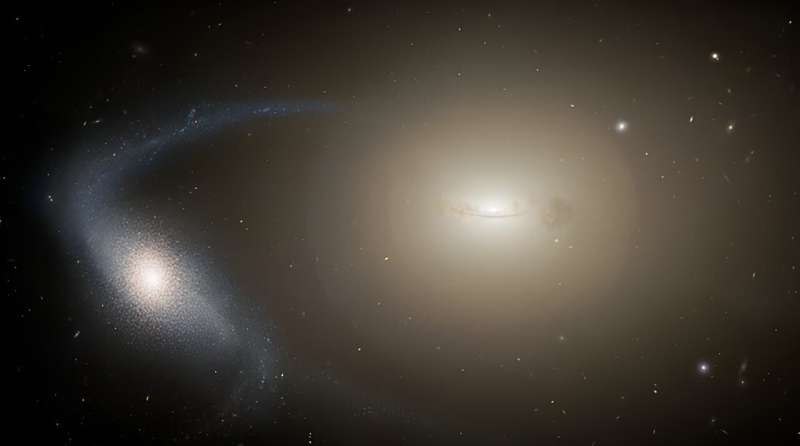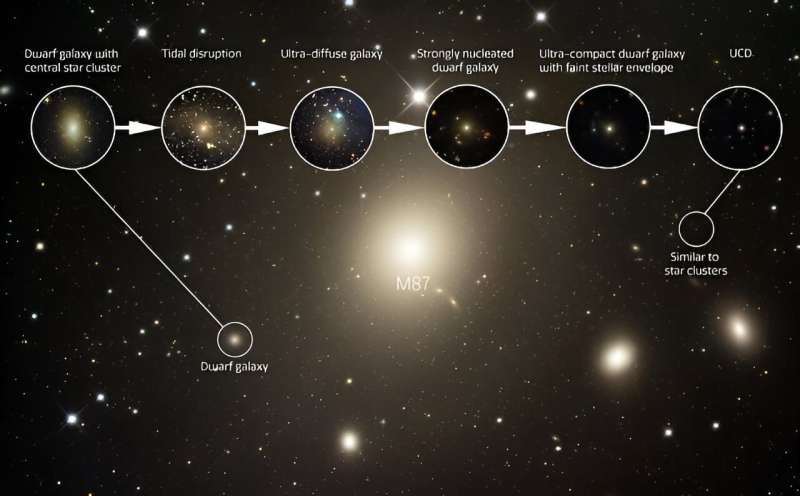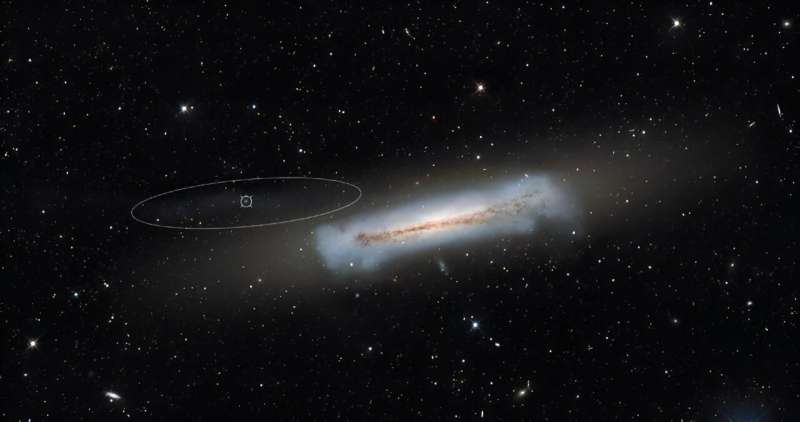Astronomers using the Gemini North telescope, one-half of the International Gemini Observatory operated by NSF’s NOIRLab, have captured the eroding remains of more than 100 dwarf galaxies as they transition into ultra-compact dwarf galaxies, objects with masses much greater than star clusters yet much smaller than dwarf galaxies. These findings confirm that many ultra-compact dwarf galaxies are likely the fossil remains of normal dwarf galaxies that have been stripped of their outer layers.
Ultra-compact dwarf galaxies (UCDs) are among the densest stellar groupings in the universe. Being more compact than other galaxies with similar mass, but larger than star clusters—the objects they most closely resemble—these mystifying objects have defied classification. The missing piece to this puzzle has been a lack of sufficient transitional (intermediate) objects to study. A new galaxy survey, however, fills in these missing pieces to show that many of these enigmatic objects are likely formed from the destruction of dwarf galaxies.
The work is published in the journal Nature.

The idea that UCDs are remnants of disrupted dwarf galaxies has been proposed since they were discovered over two decades ago. However, previous searches have not revealed the large population of galaxies in transition that you would expect to find.
So, an international team of astronomers conducted a systematic search for these intermediate-stage objects around the Virgo Cluster, a grouping of thousands of galaxies in the direction of the constellation Virgo. Using the Gemini North telescope near the summit of Mauna Kea in Hawaiʻi, the team identified more than 100 of these missing-link galaxies that show every stage of the transformation process.
“Our results provide the most complete picture of the origin of this mysterious class of galaxy that was discovered nearly 25 years ago,” said NOIRLab astronomer Eric Peng, a co-author on the paper describing these results. “Here we show that 106 small galaxies in the Virgo cluster have sizes between normal dwarf galaxies and UCDs, revealing a continuum that fills the ‘size gap’ between star clusters and galaxies.”

The team compiled their sample by first looking at images from the Next Generation Virgo Cluster Survey, taken with the Canada-France-Hawaiʻi Telescope. Though they could identify hundreds of candidate UCD progenitors, they could not confirm their true nature. The obstacle was that UCDs that are surrounded by envelopes of stars are indistinguishable from normal galaxies that are located farther away beyond the Virgo Cluster.
To distinguish the candidate UCD progenitors from the background galaxies, the team performed follow-up spectroscopic studies with Gemini North to obtain more concrete measurements of their distances. These observations allowed the astronomers to eliminate all of the background galaxies from their samples until only the UCDs within the Virgo Cluster remained.
Scattered among this vast survey are many dwarf galaxies that contain ultra-compact central star clusters. These galaxies represent the early stages of the transformation process and suggest that after neighboring massive galaxies strip these dwarfs of their outer layers of stars and gas, what remains will be an object identical to the late-stage UCDs that have already been identified.

The researchers also found many objects with very extended and diffuse stellar envelopes around them, indicating that they are currently in the throes of transitioning as their stars and dark matter are stripped away. Within their extensive sample, the team identified objects at several other stages of the evolutionary process, that when placed in sequence, tell a compelling story of the morphology of UCDs. Furthermore, nearly all the candidates were near massive galaxies, suggesting that their local environment played an important role in their formation.
“Once we analyzed the Gemini observations and eliminated all the background contamination, we could see that these transition galaxies existed almost exclusively near the largest galaxies. We immediately knew that environmental transformation had to be important,” said Kaixiang Wang, a Ph.D. student at Peking University and lead author of the paper.
Besides identifying the environment UCDs live in, these results also lend valuable insight into how many of these objects there are and what the full sequence of their evolutionary change looks like.
“It’s exciting that we can finally see this transformation in action,” said Peng. “It tells us that many of these UCDs are visible fossil remnants of ancient dwarf galaxies in galaxy clusters, and our results suggest that there are likely many more low-mass remnants to be found,” he added.
“This study illustrates how large surveys can improve our understanding of the biggest questions in astronomy, like galaxy evolution,” says Chris Davis, NSF Program Director for NOIRLab. “NSF’s NOIRLab is a world leader in supporting astronomical surveys and—importantly—providing community and public access to the data and the amazing resulting discoveries.”
More information:
Kaixiang Wang et al, An evolutionary continuum from nucleated dwarf galaxies to star clusters, Nature (2023). DOI: 10.1038/s41586-023-06650-z
Provided by
National Science Foundation
Citation:
Dwarf galaxies stripped of stars prove to be the missing link in the formation of rare ultra-compact dwarf galaxies (2023, November 8)
retrieved 10 November 2023
from
This document is subject to copyright. Apart from any fair dealing for the purpose of private study or research, no
part may be reproduced without the written permission. The content is provided for information purposes only.